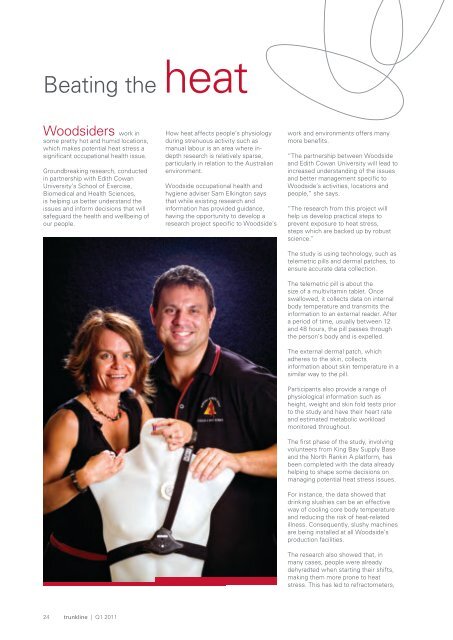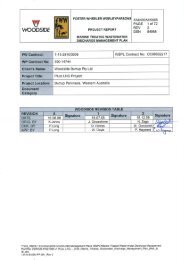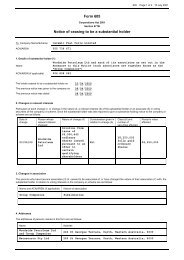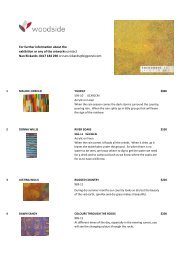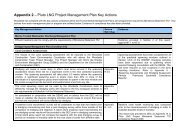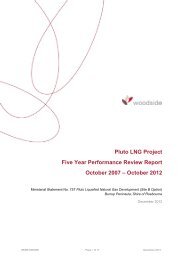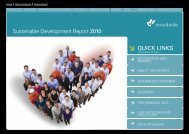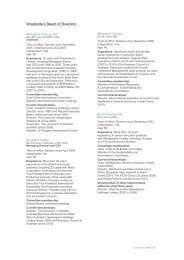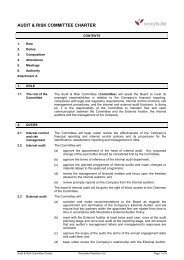trunkline - Woodside
trunkline - Woodside
trunkline - Woodside
You also want an ePaper? Increase the reach of your titles
YUMPU automatically turns print PDFs into web optimized ePapers that Google loves.
Beating the heat<br />
<strong>Woodside</strong>rs work in<br />
some pretty hot and humid locations,<br />
which makes potential heat stress a<br />
significant occupational health issue.<br />
Groundbreaking research, conducted<br />
in partnership with Edith Cowan<br />
University’s School of Exercise,<br />
Biomedical and Health Sciences,<br />
is helping us better understand the<br />
issues and inform decisions that will<br />
safeguard the health and wellbeing of<br />
our people.<br />
24 <strong>trunkline</strong> | Q1 2011<br />
How heat affects people’s physiology<br />
during strenuous activity such as<br />
manual labour is an area where indepth<br />
research is relatively sparse,<br />
particularly in relation to the Australian<br />
environment.<br />
<strong>Woodside</strong> occupational health and<br />
hygiene adviser Sam Elkington says<br />
that while existing research and<br />
information has provided guidance,<br />
having the opportunity to develop a<br />
research project specific to <strong>Woodside</strong>’s<br />
work and environments offers many<br />
more benefits.<br />
“The partnership between <strong>Woodside</strong><br />
and Edith Cowan University will lead to<br />
increased understanding of the issues<br />
and better management specific to<br />
<strong>Woodside</strong>’s activities, locations and<br />
people,” she says.<br />
“The research from this project will<br />
help us develop practical steps to<br />
prevent exposure to heat stress,<br />
steps which are backed up by robust<br />
science.”<br />
The study is using technology, such as<br />
telemetric pills and dermal patches, to<br />
ensure accurate data collection.<br />
The telemetric pill is about the<br />
size of a multivitamin tablet. Once<br />
swallowed, it collects data on internal<br />
body temperature and transmits the<br />
information to an external reader. After<br />
a period of time, usually between 12<br />
and 48 hours, the pill passes through<br />
the person’s body and is expelled.<br />
The external dermal patch, which<br />
adheres to the skin, collects<br />
information about skin temperature in a<br />
similar way to the pill.<br />
Participants also provide a range of<br />
physiological information such as<br />
height, weight and skin fold tests prior<br />
to the study and have their heart rate<br />
and estimated metabolic workload<br />
monitored throughout.<br />
The first phase of the study, involving<br />
volunteers from King Bay Supply Base<br />
and the North Rankin A platform, has<br />
been completed with the data already<br />
helping to shape some decisions on<br />
managing potential heat stress issues.<br />
For instance, the data showed that<br />
drinking slushies can be an effective<br />
way of cooling core body temperature<br />
and reducing the risk of heat-related<br />
illness. Consequently, slushy machines<br />
are being installed at all <strong>Woodside</strong>’s<br />
production facilities.<br />
The research also showed that, in<br />
many cases, people were already<br />
dehyradted when starting their shifts,<br />
making them more prone to heat<br />
stress. This has led to refractometers,


